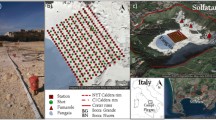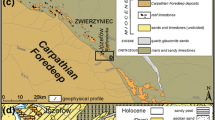Abstract
We present high-resolution Vp models of the Capo Granitola harbor, Sicily (Italy) obtained by first arrival traveltime tomography. Seismic data were collected along four hydrophone arrays on the sea-bottom and via a Watergun as seismic source, in order to plan dredging operations in the harbor. Using a hydrophone spacing of 2.5 m and shot spacing of 5 m, very high resolution quality data were recorded. Seismic tomography expands existing knowledge of the harbour subsoil with a penetration of about 20 m, illuminating the Lower Pleistocene bedrock (Marsala calcarenites) that corresponds to high-Vp regions (Vp > 4.5 km/s). Low Vp (1.8–4.5 km/s) deposits belonging to terraced calcarenites (Upper Pleistocene in age) are also well imaged; they are about 8 m thick and lie below loose sand deposits (Vp = 1.5 km/s). The substratum has an articulated morphology; Vp images unravel small steps in the basement probably related to structural discontinuities (e.g., faults). Processing data with 3D techniques enables images of the structure and the thickness of the lithotypes to be reconstructed, thus leading to large-scale, realistic estimates of the total quantity of material to be excavated or dredged. Tomographic profiles permit clear discrimination of the soft sediment above the basement and thus allow the determination of the total volume of sediment above the seismic bedrock, estimated at about 265,000 m3.

(redrawn from F. n°265 “Mazara del Vallo”). Mazara-Castelvetrano alignment (CCA) was projected using image data from ENVISAT SAR (http://www.pcn.minambiente.it); c Mean displacement velocity (in mm/year) (taken from Portale Cartografico Nazionale—http://www.pcn.minambiente.it). The yellow circle indicates the highly deformed coastline in the area of Marina di Capo Granitola harbor





Similar content being viewed by others
References
Ackermann HD, Pankratz LW, Dansereau D (1986) Resolution of ambiguities of seismic refraction traveltime curves. Geophysics 51(2):223–235
Anderson J (2009) Seismic refraction surveys as a tool for port and harbour investigations. In: Coasts and ports 2009: in a dynamic environment. Engineers Australia, Wellington, pp 231–235
Aureli A, Contino A, Cusimano G, Di Pasquale M, Hauser S, Musumeci G, Pisciotta A, Provenzano MC, Gatto L (2004) Contamination of coastal aquifers from intense anthropic activity in southwestern Sicily, Italy. In: Witkowski A, Kowalczyk A, Vrba J (ed) Groundwater vulnerability Assessment and Mapping. Selected papers from the Groundwater Vulnerability Assessment and Mapping, International Conference, Ustron, Poland, 2004. International Association of Hydrologists Selected Papers, SP 11, International Association of Hydrogeologists (I. A. H.), Taylor & Francis Group, London. Chapter 5, 63–71
Barreca G, Bruno V, Cocorullo C, Cultrera F, Ferranti L, Guglielmino F, Guzzetta L, Mattia M, Monaco C, Pepe F (2013) Geodetic, geological and geophysical evidence of active tectonics in south-western Sicily and offshore. Rend Online Soc Geol It 29:5–8 (4 fig)
Barreca G, Bruno V, Cocorullo C, Cultrera F, Ferranti L, Guglielmino F, Guzzetta L, Mattia M, Monaco C, Pepe F (2014) Geodetic and geological evidence of active tectonics in south-western Sicily (Italy). J Geodyn 82:138–149
Cha YH, Jo CH, Suh JH (2003) Water bottom seismic refraction survey for engineering applications. Geosystem Eng 6(2):40–45
Collins JA, Blackman DK, Harris A, Carlson RL (2009) Seismic and drilling constraints on velocity structure and reflectivity near IODP Hole U1309D on the central dome of Atlantis Massif, Mid-Atlantic Ridge 30°N. Geochem Geophys Geosyst 10:Q01010. doi:10.1029/2008GC002121
Cosentino P, Capizzi P, Fiandaca G, Martorana R, Messina P, Pellerito S (2007) Study and monitoring of salt water intrusion in the coastal area between Mazara del Vallo and Marsala (South-Western Sicily). In: Rossi G, Vega T, Bonaccorso B (eds). Methods and tools for drought analysis and management, series: water science and technology library, Vol 62. XVI, Springer, pp 303–321
Cramer BJ, Hiltunen DR (2004) Investigation of bridge foundation sites in karst terrane via seismic refraction tomography. 83rd Annual Meeting Compendium of Papers CD-ROM, Transportation Research Board, Washington, D.C., 11–15 January 2004
D’Angelo U, Vernuccio S (1992) Carta geologica del Foglio 617 “Marsala” scala 1:50000. Boll Soc Geol It 113
D’Angelo U, Vernuccio S (1994) Note illustrative della carta geologica del Foglio 617 “Marsala” (scala 1:50.000). Estratto dal Boll Soc Geol Ital 113:55–67
D’Angelo U, Vernuccio S (1996) I terrazzi marini quaternari dell’estremità occidentale della Sicilia. Mem. Soc. Geol. It., LI:585–594
D’Angelo U, Parrino G, Vernuccio S (2001) Il quaternario della fascia costiera compresa fra la punta Granitola e porto Palo (Sicilia sud occidentale. Nat Sicil XXV(3–4):333–344
Di Fiore V, Cavuoto G, Punzo M, Tarallo D, Pelosi N, Giordano L, Alberico I, Marsella E, Mazzola S (2015) Joining up land and marine seismic data: case study from Procida and Ventotene Islands (Tyrrhenian Sea, Italy). Geophysics 80(6), EN153–EN166. doi:10.1190/geo2014-0392.1)
Driscoll NW, Karner GD (1991) 33. Deconvolving water-gun Seismic Data. In: Weissel J, Peirce J, Taylor E, Alt J, et al. Proceedings of the Ocean Drilling Program, Scientific Results, Vol. 121: College Station, TX (Ocean Drilling Program),pp 663–679. doi:10.2973/odp.proc.sr.121.156.1991
French WS, Henson CG (1978) Signature measurements on the water gun marine seismic source. Proceedings of offshore technology conference, OTC, vol 3124, pp 631–634.
Gallant EV, Stewart RR, Lawton DC, Bertram MB, Rodriguez C (1996) New technologies in marine seismic surveying: overview and physical modelling experiments. CREWES Research Report—Volume 8.
Geometrics (2006) SeisImager/2D Manual Version 3.2: Plotrefa v. 2.8: Advanced Geoseiences. Inc. San Jose
Geoportale Nazionale - Ministero dell’Ambiente e della Tutela del Territorio e del Mare. Prodotti interferometrici - Confronto ERS ENVISAT ascending. http://www.pcn.minambiente.it
Gilbert H (1972) Iterative methods for the three-dimensional reconstruction of an object from projections. J Theor Biol 36:105–117
Golden Software, Inc (2012) Voxler version 3.3 - Software for 3D Data Visualization. Golden Software
Hayashi K, Takahashi T (1997) High resolution seismic refraction method using surface and borehole data for site characterization of rocks. Int J Rock Mech Min Sci 38: 807–813
Hearn TM, Ni JF (1994) Pn velocities beneath continental collision zones: the Turkish-Iran Plateau. Geophys J Int 117:273–283
Iyer HM, Hirahara K (1993) Seismic tomography: theory and practice. Chapman & Hall, London
Krajewski C, Dresen L, Gelbke C, Ruter H (1989) Iterative tomographic methods to locate low-velocity anomalies: a model study. Geophys Prospect 37:717–751
Landmark Graphics Corporation (1997) ProMAX -A reference guide for the ProMAX geophysical processing software, Vol 2. Halliburton Company
Lugg R (1979) Marine seismic sources. In: Fitch AA (ed) Developments in geophysical exploration methods-l. Applied Science Publishers, London, pp 143–203
MacGregor F, Fell R, Mostyn GR, Hocking G, McNally G (1994) The estimation of rock rippability. Q J Eng Geol Hydrogeol 27:123–144
Moldoveanu N, Spradley M (2004) Vertical hydrophone arrays solve transition zone challenges Ghosting during data processing is nearly eliminated by a new method. World oil. 225(7):89–94 (http://www.worldoil.com/July-2004-Vertical-hydrophone-arrays-solve-transition-zone-challenges.html).
Morey D, Schuster GT (1999) Paleoseismicity of the Oquirrh fault, Utah from shallow seismic tomography. Geophy J Int 138:25–35
Nemeth T, Normark E, Qin F (1997) Dynamic smoothing in cross-well traveltime tomography, Geophysics 62:168–176
Oyo Corporation (2001) SeisImager Users Manual and 2D Refraction Analysis Software for Windows
Parasnis DS (1997) Principles of applied geophysics, 5th edn. Chapman and Hall, London, p 1997
Ruggieri G, Torre G (1973) Geologia delle zone investite dal terremoto del Belice. La Tavoletta di Gibellina. Riv Min Sic 132–139:127–187
Ruggieri G, Unti A, Unti M, Morono MA (1977) La calcarenite di Marsala (pleistocene inferiore) e i terreni contermini. Estratto dal Boll Soc Geol Ital 94:1623–1655
Sandmeier KJ (2008) REFLEXW – Windows TM9x/NT/2000/XP-program for the processing of seismic, acoustic or electromagnetic reflection, refraction and transmission data
Vidale J (1988) Finite-difference calculation of travel-times. Bull Seismol Soc Am 78(6):2062–2076
Whiteley RJ, Stewart SB (2008) Case studies of shallow marine investigations in Australia with advanced underwater seismic refraction (USR). Explor Geophys 39(1):34–40
Williams SJ (1981) Sand resources and geological character of long island sound. Technical Paper No. 81–3. Coastal Engineering and Research Center U.S. Army Corps of Engineers
Zelt CA (1998) Lateral velocity resolution from three-dimensional seismic refraction data. Geophys J Int 135:1101–1112
Zelt CA, Azaria A, Levander A (2006) 3D seismic refraction traveltime tomography at a ground water contamination site. Geophysics 71:H67–H78
Zhang J, Toksöz MN (1998) Nonlinear refraction traveltime tomography. Geophys 63(5):1726–1737
Acknowledgements
The authors are grateful to Dr. Salvatore Mazzola for supporting this research. The authors wish to thank Mr. Paolo Scotto di Vettimo, Mr. Michele Iavarone for their technical support during the field data acquisition; to Dr. Ines Alberico and Dr. Nicola Pelosi for their scientific support. Many thanks are due to Dr. Giorgio Tranchida for providing the well log data; to Dr. Mario Sprovieri and Mr. Vincenzo Di Stefano for their technical support and availability. The authors would like to thank the reviewers for their valuable comments and remarks.
Author information
Authors and Affiliations
Corresponding author
Rights and permissions
About this article
Cite this article
Punzo, M., Cavuoto, G., Tarallo, D. et al. Ensuring very shallow-water sediment properties: case study from Capo Granitola harbour, Sicily (Italy). Mar Geophys Res 38, 313–323 (2017). https://doi.org/10.1007/s11001-017-9313-8
Received:
Accepted:
Published:
Issue Date:
DOI: https://doi.org/10.1007/s11001-017-9313-8




